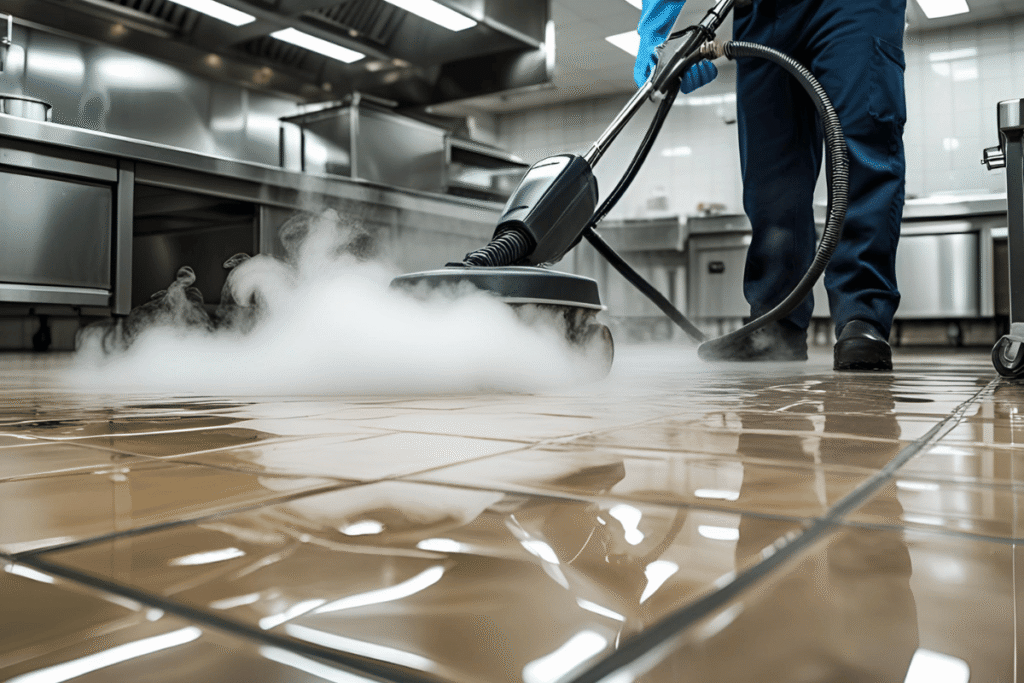Epoxy flooring is widely used across commercial environments for its durability, non-porous surface, and resistance to chemicals and abrasions. Found in warehouses, medical labs, food production areas, and commercial garages, epoxy-coated floors require systematic care to maintain their clean appearance and protective qualities.
While epoxy is designed to be low maintenance, improper cleaning techniques, harsh chemicals, and buildup from daily use can degrade its finish and reduce its lifespan. Canadian facilities also contend with seasonal debris, salt residue, and heavy equipment wear factors that make regular cleaning essential.
This guide offers a structured approach to epoxy floor maintenance, detailing the safest and most effective methods suitable for commercial properties seeking compliance, cleanliness, and environmental responsibility.
1. Begin With Dry Debris Removal
Use a wide microfiber dust mop or a soft-bristle push broom to collect surface dirt, dust, and abrasives. Epoxy floors can be scratched by grit and fine particles, particularly in warehouse or entry areas where foot traffic or forklifts track in outdoor debris.
Avoid using traditional stiff-bristle brooms, as these can scuff the finish over time. This is especially important in colder months when sand and salt are prevalent.
2. Damp Mop With Warm Water and pH-Neutral Cleaner
For general maintenance, prepare a solution of warm water and a pH-neutral cleaner approved for epoxy surfaces. Avoid citrus-based, acidic, or alkaline cleaners such as vinegar, bleach, or ammonia which can dull or weaken the epoxy over repeated applications.
Use a non-abrasive mop, preferably microfiber, to evenly apply the solution. Rinse thoroughly to remove any residue, and allow the floor to air-dry or use a wet vac for quicker drying in large commercial spaces.
3. Address Grease and Oil With Safe Degreasers

In automotive bays or industrial zones where spills are common, apply a biodegradable degreaser specifically labelled for use on coated floors. Let it sit for 3–5 minutes, scrub gently with a soft brush or rotary floor machine, and rinse completely.
Ensure products are certified as low-VOC and free of petroleum solvents to align with environmental standards and improve indoor air quality.
4. Remove Stubborn Buildup With Soft Scrubbing
If the epoxy coating has built-up grime or embedded stains especially in corners or machinery zones use a soft-bristle deck brush or orbital buffer. For an effective solution, combine warm water with a pH-neutral floor cleaner and a few drops of eco-friendly dish detergent.
Consistent deep scrubbing every two to three weeks in high-use areas will help prevent deterioration of the coating and improve floor aesthetics. For more detailed advice on handling deep-cleaning in large spaces, explore this guide on how to clean concrete basement floors.
5. Avoid Harsh or Abrasive Tools
Never use steel wool, scrapers, or stiff rotary pads on epoxy surfaces. These tools can gouge the coating, making it more susceptible to damage from moisture and chemicals. Instead, use commercial pads designed for epoxy floor finishes and always spot test before applying mechanical methods across a full area.
6. Steam Cleaning for Sanitation

In industries requiring sterile or hygienic conditions such as laboratories or food production steam cleaning offers a chemical-free sanitation method. High-temperature vapour effectively breaks down oil, kills bacteria, and lifts fine residues without abrasive scrubbing.
However, avoid excessive moisture pooling, especially in joints or seams where epoxy may not be completely sealed. Use steam in controlled, measured applications with immediate vacuum drying.
7. Seasonal Cleaning Adjustments
Epoxy floors in Canadian climates are vulnerable to salt, slush, and moisture during winter. Salt residue not only causes white staining but can chemically wear down the surface over time. During peak winter months, increase frequency of mopping with warm water and use mats at all entry points.
It is also advisable to rotate deeper cleaning efforts with focus on salt-heavy zones. This seasonal care approach is consistent with strategies outlined in our article on how to clean tile grout in commercial spaces, which highlights the hidden impact of winter contaminants.
8. Use Auto-Scrubbers With Care
For facilities such as factories, schools, or arenas with expansive epoxy surfaces, auto-scrubbers significantly reduce cleaning time. Equip these machines with non-aggressive pads and use only approved cleaning agents to avoid compromising the epoxy’s bond.
Scheduling auto-scrubbing weekly or biweekly improves floor traction and visual appeal without overexposing the coating to moisture or abrasion. Complement this practice with insights from how to clean linoleum floors, which also discusses pad selection and water management.
9. Recoat When Necessary
Even with proper cleaning, epoxy floors may show signs of wear over the years especially in forklift lanes or customer-facing zones. If the floor becomes dull or discoloured, recoating with a water-based epoxy solution can restore appearance and performance.
Plan this proactively every 3–5 years depending on traffic volume, and avoid waiting until the base layer is exposed.
10. Engage a Commercial Cleaning Service in Kitchener
Consistent epoxy floor maintenance requires more than daily janitorial tasks. Partnering with a commercial cleaning service in Kitchener ensures that floors are managed using the correct tools, solutions, and schedules.
A provider experienced in epoxy flooring will understand how to balance chemical safety with surface preservation, offering scalable solutions for daily, weekly, and seasonal needs. This reduces long-term maintenance costs and helps facilities meet cleanliness and safety standards.
Final Thoughts
Epoxy floors offer commercial facilities long-term value, strength, and cleanliness but only when maintained with informed care. Understanding the properties of epoxy, the risks posed by seasonal changes, and the demands of high-traffic areas is critical to proper upkeep.
From routine pH-neutral mopping and spot degreasing to scheduled deep cleans and environmentally friendly practices, these methods help retain the integrity of the surface. Businesses managing multiple flooring types may also benefit from reviewing best practices in how to clean vinyl plank flooring or how to clean marble floors.
Proper cleaning protocols not only protect your flooring investment they also promote a healthier, safer environment for employees and customers alike. For optimal results, facility managers should consider scheduling regular service with professionals who understand the science of epoxy floor care.



